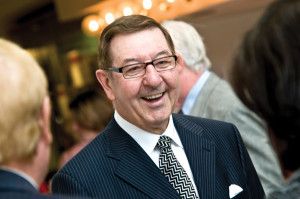
When he came to the University of Ottawa Heart Institute on April 2, 2004, Robert Roberts, MD, was well established as an international leader in cardiovascular genetics and research. He arrived with a mandate to put research at the Heart Institute on par with the world-class care and training the organization was already known for.
By any measure, he achieved this goal with resounding success. In 2012, the Heart Institute ranked in the top 2 per cent worldwide out of 3,042 research organizations for the quality and impact of its scientific publications. In parallel, the Heart Institute’s reputation as an international leader in research and innovation has soared to match its achievements.
Dr. Roberts accomplished this, in part, through the direct impact of genetics research at the Heart Institute and the Ruddy Canadian Cardiovascular Genetics Centre that he founded, as well as through building research capacity. He grew the Heart Institute’s research endowment by 150 per cent, to $56 million, one of the largest such endowments in North America dedicated to cardiovascular research.
“My time at the Heart Institute has truly been the most outstanding 10 years of my life.”
– Dr. Robert Roberts, President and CEO, UOHI
But more important, he fostered a broad culture of research and innovation in the service of advancing cardiovascular medicine and patient care. “He encouraged the pursuit of research and encouraged new innovations,” said Heather Sherrard, Vice President of Clinical Services. “He let people innovate and do what they do well.”
That innovation can be seen not just in the laboratories but in clinical research and the delivery of care. Clinical programs have flourished under Dr. Roberts, including electrophysiology, with the growth of complex ablations to treat arrhythmias and cardiac imaging for the diagnosis and management of heart disease. The Heart Institute is now an acknowledged leader in clinical cardiac imaging research.
Of course, many practical issues had to be addressed along the way. Upon his arrival at the Heart Institute, Dr. Roberts was faced with the difficulty of wait times for cardiac catheterization and electrophysiology (EP) procedures that ran to two to three months. “He was instrumental in working with the province to get expanded catheterization and EP facilities to address the problem,” said cardiologist and former Chief of Cardiology Terry Ruddy, MD. “Today, we have essentially no waiting time for these core procedures.”
Another major achievement was navigating the long road to obtain funding for a new building. He recognized early on the need to expand the facility and drove the effort to get funding allocated. That eventually came to pass in 2011. Most planning and design is now completed, and groundbreaking is scheduled for the fall of this year.

“Dr. Roberts accelerated the Heart Institute’s development in so many areas,” remarked Chief of Prevention and Rehabilitation Andrew Pipe, MD, at a recent farewell celebration. “Under his leadership, the Heart Institute has achieved a higher profile regionally, nationally and internationally. Today, we are recognized as the pre-eminent cardiac institute in Canada.”
“My time at the Heart Institute has truly been the most outstanding 10 years of my life,” Dr. Roberts told the audience at that celebration. “I left Canada in 1971 on a scholarship from the Ontario Heart Foundation and spent most of my career in the United States. Coming to the Heart Institute 10 years ago gave me the opportunity to give something back to the country that has given me everything. That has meant a great deal to me.”
“When I came to the Heart Institute, everyone told me it was a special place. It had a phenomenal reputation that clearly had been instilled by its founder, Dr. Wilbert Keon. And fortunately for me, I have had the opportunity to be a part of that and, indeed, appreciate that this is a very special place.”

